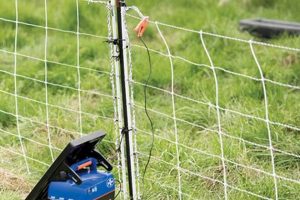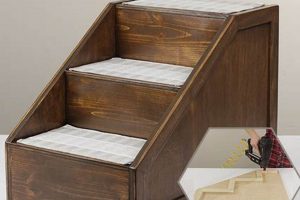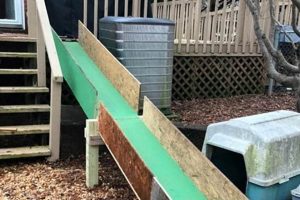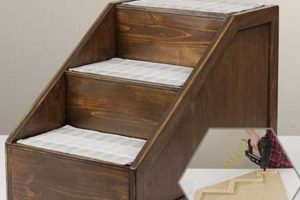Constructing canine agility equipment at home involves creating various obstacles designed to test a dog’s speed, coordination, and obedience. These self-made structures replicate professional courses, offering a cost-effective alternative for training. Examples include hurdles of adjustable heights, tire jumps crafted from repurposed materials, and weave poles fabricated from PVC piping.
Homemade agility courses provide numerous advantages. They allow owners to customize the training environment to their dog’s specific needs and abilities. Furthermore, the process of building such equipment fosters creativity and problem-solving skills for the owner. Historically, agility training was primarily limited to professional facilities. The increasing accessibility of materials and information has made the practice more democratized.
The following sections will detail the specific types of obstacles that can be built, the materials commonly employed in their construction, and the safety considerations that must be taken into account to ensure a positive and secure training experience.
Tips for Constructing Canine Agility Obstacles at Home
Creating agility equipment at home necessitates careful planning and execution. The following tips provide guidance on optimizing the process for safety and effectiveness.
Tip 1: Prioritize Safety. Thoroughly inspect all materials for sharp edges, splinters, or potential hazards. Sand down rough surfaces and ensure all fasteners are securely tightened. Regularly check equipment for wear and tear to prevent accidents.
Tip 2: Choose Durable Materials. Opt for weather-resistant materials such as treated lumber, PVC piping, or recycled plastic. These materials withstand outdoor conditions and prolong the lifespan of the equipment.
Tip 3: Design for Adjustability. Incorporate adjustable height settings into jump designs. This allows for gradual progression in training and accommodates dogs of various sizes and skill levels.
Tip 4: Follow Established Dimensions. Consult agility course guidelines to ensure equipment dimensions comply with standard regulations. This facilitates smoother transitions to formal training or competitions.
Tip 5: Secure the Base. Provide stable bases for all obstacles, especially jumps and weave poles. Consider using weighted bases or ground stakes to prevent tipping during use.
Tip 6: Plan the Layout. Strategically position obstacles to maximize training space and minimize potential collisions. Ensure ample room for dogs to approach and navigate each obstacle safely.
Tip 7: Introduce Obstacles Gradually. Allow dogs to acclimate to each obstacle individually before incorporating them into complex courses. Positive reinforcement and patient guidance are essential.
Tip 8: Store Equipment Properly. When not in use, store equipment in a dry, sheltered location to prevent damage from the elements. This extends the equipment’s usability and minimizes maintenance.
Adhering to these guidelines will enhance the safety, durability, and effectiveness of homemade agility equipment, promoting a positive training experience for both dog and owner.
The subsequent section will address advanced construction techniques and customization options for homemade agility courses.
1. Jump Height Adjustment
Jump height adjustment is a critical feature in self-constructed canine agility jumps. The inability to modify jump height limits the effectiveness of the training regimen. Insufficient height does not challenge the dog, failing to develop its jumping abilities adequately. Conversely, excessive height presents an elevated risk of injury, particularly for novice dogs or those with pre-existing physical conditions. Adjustable jumps allow for graduated increases in difficulty, promoting safe and effective skill development.
For example, a Border Collie, known for its athleticism, may require higher jump settings to maintain engagement and continue to improve. Conversely, a smaller breed like a Dachshund or an older dog with arthritis necessitates significantly lower settings to minimize strain. Adjustable jumps, therefore, permit tailored training programs, ensuring each dog receives appropriate challenges without undue risk. Practical application lies in utilizing standardized agility jump height guidelines as a starting point and adjusting based on individual assessment and observation during training sessions.
In summary, the incorporation of height adjustment capabilities into homemade agility jumps is essential for ensuring safety and maximizing training benefits. The capacity to customize jump heights according to a dog’s individual needs promotes gradual progression, minimizes injury risk, and ultimately enhances the overall agility training experience. Challenges exist in designing adjustment mechanisms that are both secure and easily manipulated, but overcoming these design obstacles is crucial for creating effective and safe equipment.
2. Material Durability
Material durability directly impacts the long-term utility and safety of homemade canine agility jumps. The selection of appropriate materials for constructing these structures determines their ability to withstand repeated use, exposure to environmental conditions, and the potential impact from dogs during training. Inadequate material selection results in premature degradation of the equipment, posing safety hazards and requiring frequent repairs or replacements. Consider, for instance, the consequence of constructing jump bars from brittle plastic; these are prone to snapping under pressure, creating sharp fragments that could injure a dog. Conversely, using pressure-treated lumber for jump supports ensures structural integrity and resistance to rot, extending the equipment’s lifespan.
The correlation between material durability and the overall cost-effectiveness of homemade agility jumps is significant. While inexpensive materials may initially seem appealing, their lack of durability often leads to higher long-term expenses due to the need for frequent replacements. For example, PVC piping, when used for weave poles, offers a balance between cost and durability, being both lightweight and relatively resistant to breakage. Similarly, choosing rust-resistant hardware, such as galvanized screws and bolts, prevents corrosion and maintains the structural stability of the jumps over time. The selection of weather-resistant paints or sealants further protects the materials from moisture damage and UV degradation, preserving the equipment’s appearance and extending its functionality.
In conclusion, material durability is not merely a desirable attribute but a critical component in the successful creation of safe and cost-effective canine agility jumps. The informed selection of robust, weather-resistant materials, coupled with proper construction techniques, ensures the longevity and usability of the equipment. Prioritizing durability mitigates safety risks, reduces long-term costs, and enhances the overall training experience for both dog and handler.
3. Safety Considerations
The inherent connection between safety considerations and the construction of canine agility jumps at home is undeniable, and a failure to adequately address potential hazards can result in injury to the animal. The causality is direct: improper construction techniques or inadequate materials create unstable or dangerous equipment, increasing the risk of slips, falls, and collisions. For example, jump bars constructed of heavy materials, such as solid wood, can cause significant harm if dislodged during a jump attempt. A lighter, break-away bar, made of PVC pipe, reduces this risk. The absence of non-slip surfaces on ramps or A-frames creates a slipping hazard, potentially leading to strained muscles or joint injuries. Therefore, prioritizing safety considerations is not merely an ancillary aspect of building agility jumps, but rather a fundamental requirement for responsible construction.
Real-world examples underscore the practical significance of these considerations. Veterinary clinics frequently treat agility-related injuries stemming from poorly designed or maintained equipment. These injuries range from minor sprains to severe fractures, necessitating costly veterinary care and prolonged recovery periods. Addressing sharp edges or protruding hardware reduces laceration risks, while providing adequate spacing between weave poles minimizes collision hazards. Furthermore, the placement of agility equipment should take into account the surrounding environment, ensuring sufficient clear space to prevent dogs from running into fences, trees, or other obstacles. Regular inspection and maintenance of equipment are also critical; weathering and wear can compromise structural integrity over time, introducing new safety risks.
In conclusion, the fabrication of agility jumps must be undertaken with a proactive and comprehensive approach to safety. This necessitates the careful selection of materials, meticulous construction techniques, and diligent maintenance practices. By integrating safety considerations into every stage of the building process, the risk of injury is significantly reduced, allowing dogs to enjoy the physical and mental benefits of agility training without undue hazard. The challenge lies in balancing cost-effectiveness with safety requirements, and a willingness to invest in quality materials and sound construction methods is essential for ensuring a positive and secure training environment.
4. Portability/Storage
The practicality of homemade canine agility jumps is significantly influenced by their portability and storage characteristics. Agility training often occurs in diverse locations, and storage space is frequently limited, necessitating consideration of these factors during the design and construction phases.
- Collapsible Designs
Collapsible jump designs are integral to optimizing portability and storage. Jumps constructed with hinges or detachable components can be easily folded or disassembled, reducing their footprint for transportation and storage. The implementation of such designs is particularly beneficial for individuals with limited storage space or those who frequently relocate their training setup. For instance, a jump that can be disassembled into flat components facilitates convenient storage in a garage or shed.
- Lightweight Materials
The choice of lightweight materials, such as PVC piping or aluminum, directly contributes to the ease of transporting agility jumps. Heavier materials, while potentially more durable, increase the burden associated with moving the equipment between training locations and storage areas. Lighter materials also reduce the risk of injury during handling. The use of lightweight alternatives permits easier maneuverability, especially for individuals who may have physical limitations.
- Modular Construction
Employing a modular construction approach allows for the creation of agility jumps that can be easily assembled and disassembled, promoting both portability and efficient storage. Modular designs typically consist of interchangeable components that can be quickly connected or disconnected without the need for specialized tools. This facilitates rapid setup and takedown of the agility course, making it suitable for temporary training locations or events. For example, a jump constructed from interlocking PVC sections can be assembled and disassembled in a matter of minutes.
- Stackable Components
The design of stackable components optimizes storage efficiency. Jumps and their constituent parts can be designed to nest within one another, minimizing the amount of space required for storage. This approach is particularly useful for individuals who have limited storage capacity. Stackable components facilitate organized storage and prevent damage to the equipment. For instance, jump cups designed to stack neatly within a container help maintain a tidy storage area and protect the cups from breakage.
The integration of these portability and storage considerations into the design and construction of homemade agility jumps enhances their usability and practicality. By prioritizing collapsible designs, lightweight materials, modular construction, and stackable components, individuals can create agility courses that are both functional and easy to manage, regardless of their available space or training location.
5. Construction Simplicity
The direct relationship between construction simplicity and successful DIY dog agility jump projects is undeniable. The inherent complexity of a design correlates inversely with the likelihood of completion, particularly for individuals with limited carpentry or fabrication experience. Overly intricate designs introduce opportunities for errors in measurement, cutting, and assembly, leading to structural instability or compromised functionality. For example, an elaborate adjustable jump mechanism involving multiple moving parts increases the probability of mechanical failure and requires a higher level of technical skill. Conversely, a straightforward design employing basic joinery techniques, such as a simple A-frame jump with fixed height, offers a greater chance of successful execution and safe operation.
The importance of construction simplicity extends beyond mere project completion; it directly impacts the safety and long-term usability of the equipment. Simplified designs often utilize readily available materials and require minimal specialized tools, reducing the overall cost and increasing accessibility. For example, jump bars made from standard PVC pipe are easy to cut and assemble, and their lightweight nature minimizes the risk of injury if accidentally dislodged during a jump. Furthermore, a simplified design facilitates easier maintenance and repair, as replacement parts are readily sourced and installation procedures are less complex. The selection of straightforward construction methods is, therefore, not merely a matter of convenience but a strategic decision that promotes both safety and sustainability.
In summary, prioritizing construction simplicity in DIY dog agility jump projects is essential for maximizing the likelihood of successful completion, ensuring safety, and minimizing long-term maintenance costs. The adoption of straightforward designs employing readily available materials and basic construction techniques empowers individuals with varying skill levels to create functional and safe training equipment for their canine companions. Challenges exist in balancing design simplicity with desired features, but the benefits of ease of construction ultimately outweigh the perceived advantages of overly complex designs. The focus should remain on creating safe, functional, and easily maintainable equipment that enhances the agility training experience.
Frequently Asked Questions
The following addresses common inquiries concerning the design, construction, and maintenance of dog agility jumps created at home.
Question 1: What is the appropriate height for agility jumps?
The recommended jump height varies depending on the dog’s size. Standard agility guidelines dictate that the jump height should correspond to the dog’s height at the withers (the highest point of the shoulders). Consult official agility organization guidelines for specific measurements. Never force a dog to jump higher than what is safe or comfortable for their breed and physical condition.
Question 2: Which materials are best suited for building agility jumps?
Durable, weather-resistant materials such as PVC piping, treated lumber, and recycled plastic are commonly used. The specific choice of material should consider factors such as cost, weight, and resistance to weathering. Avoid materials with sharp edges or splinters that could cause injury.
Question 3: What are the essential safety precautions to observe during construction?
Wear appropriate safety gear, including eye protection and gloves. Ensure all cuts are smooth and free of sharp edges. Use secure fastening methods and regularly inspect equipment for wear and tear. Select a construction site free of obstructions and hazards.
Question 4: How can adjustable jump heights be implemented in homemade agility jumps?
Adjustable jump heights can be achieved through various mechanisms, including adjustable jump cups, sliding sleeves, or telescoping supports. The adjustment mechanism should be secure and easy to manipulate, allowing for quick height modifications during training.
Question 5: How should agility jumps be stored when not in use?
Store agility jumps in a dry, sheltered location to protect them from the elements. Disassemble the jumps if possible to conserve storage space. Protect jump bars from bending or warping by storing them horizontally or suspending them from a rack.
Question 6: Is it necessary to adhere to official agility jump dimensions?
Adhering to official agility jump dimensions is recommended if the intention is to prepare the dog for competitive agility trials. Familiarity with standard dimensions can facilitate a smoother transition to formal training or competition environments. However, for recreational training, some deviation from standard dimensions is acceptable, provided safety is not compromised.
Careful planning and adherence to safety guidelines are paramount when constructing agility jumps.
The subsequent section will delve into the design considerations specific to individual agility obstacles.
Conclusion
The preceding exploration of DIY dog agility jumps has underscored the core principles necessary for their successful creation and implementation. Material selection, construction techniques, safety considerations, and portability all contribute to the effectiveness of these training tools. Properly constructed and maintained agility jumps offer a cost-effective means to enhance a dog’s physical fitness, mental stimulation, and owner-dog bond.
The responsible construction of agility equipment ultimately rests upon the commitment of the owner. Diligence in design and construction, coupled with ongoing safety checks, ensures the well-being of the animal. Owners are encouraged to consult professional agility trainers for guidance and to continually assess their dog’s capabilities during training. The commitment to responsible training will foster a safer and more rewarding experience for both dog and owner.







